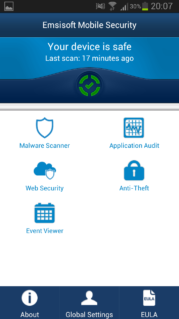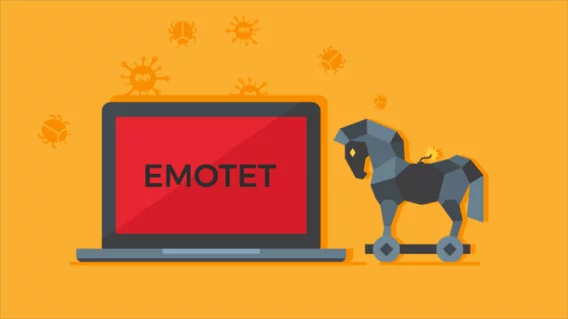Why you need an anti-malware app (but not a rogue one)

 As of late, a lot of attention has been shifted towards smartphone security. This attention comes from all angles. Roughly 22% of the world’s population owns a smartphone or a mobile device. That gives your everyday thug a 1-in-5 chance that they’ll find something valuable to steal the next time they decide to mug someone on the streets.
As of late, a lot of attention has been shifted towards smartphone security. This attention comes from all angles. Roughly 22% of the world’s population owns a smartphone or a mobile device. That gives your everyday thug a 1-in-5 chance that they’ll find something valuable to steal the next time they decide to mug someone on the streets.
Since there are roughly 7 billion people on planet Earth, that also gives cybercriminals roughly 1.5 billion targets to infect when they create mobile malware.
Smartphone security response
These big number statistics have prompted response from security-minded organizations around the world. In April, a number of mobile device manufacturers signed the Smartphone Anti-Theft Voluntary Commitment. This commitment represents a promise from some of the largest smartphone manufacturers in the world to include a preloaded anti-theft kill switch in all smartphones manufactured after July 2015. Kill switches like these will allow users to remotely lock and deactivate their smartphone in the event it is stolen.
As the commitment’s title points out, signing it was voluntary; however, some governments have made or are working to make built-in anti-theft kill switches the law. Minnesota state is one such government. Accordingly, after July 1st, 2015 all smartphones sold in Minnesota will require “preloaded anti-theft functionality or [option] of downloading that functionality.” (See full law here.) California state, proverbial home of Silicon Valley, is another such government – however the law has yet to be passed. (See proposed bill here.) In both cases, high physical crime rates are cited as legislative impetus.
Naturally, manufacturer and governmental response has inspired new mobile security products across the board. It may very well be that many manufacturers will include anti-theft kill switches in their smartphone products after July 2015, but many security software developers have realized that consumers need a solution in the meantime. Furthermore, anti-theft kill switches do not protect users from mobile malware.
Emsisoft Mobile Security – Accept no substitute
Here at Emsisoft, our first response to the smartphone crime wave is Emsisoft Mobile Security. Emsisoft Mobile Security provides remote anti-theft capabilities AND mobile malware protection. It can also prevent you from downloading malicious apps in real-time, as they arrive.
That third capability is particularly relevant in light of yet another trend which can be attributed to the increased public awareness of smartphone security: rogue antivirus apps! If it sometimes seems like there is no end to the deep, dark deviousness of your average cybercriminal’s imagination, rogue mobile antivirus apps provide all the more proof of such suspicion.
As these fraudulent security solutions exist on the PC, they now also exist as mobile apps. And, in fact, because cybercriminals are always looking for low investment strategies to cash in big, many of these “apps” are designed to do absolutely nothing at all. In early April, one such app by the name of Virus Shield achieved over 10,000 downloads, and all it did was change its graphic display from a warning X-mark to a check. Virus Shield featured absolutely no anti-theft capabilities, and it did not scan for malware. It also sold for $4 a pop.
More recently, independent reports indicate the presence of a number of rogue mobile antivirus apps on both Google Play and the Windows Phone store that again do absolutely nothing but dupe the user into thinking their device is secured. This time around, the apps feature falsified branding from legitimate software developers, including Mozilla, Avira, and Kaspersky Labs. Most of these apps are being sold for only a few dollars apiece, and fortunately none of them feature any malicious functionality outside of being total scams. Unfortunately, this not-so-malicious design is also the reason why these apps slip through to market in the first place, as most app marketplace security measures are designed to detect malware proper.
Watch out for mobile malware too
Stolen smartphones and fake anti-virus solutions cost their victims cash, but these petty crimes pale in comparison to what can be done with mobile malware. One of the most common techniques is to infect victims with an SMS Trojan, which surreptitiously connects the mobile device to a premium service and charges exorbitant rates for use. Even worse is malware like the iBanking rogue and OldBoot, both of which can be used to carry out identity theft. Perhaps most alarming of all is a recent report that shows ransomware is headed mobile too.
All of these developments point to a future where mobile security is a primary concern. That’s why as an anti-malware company, we’re offering a mobile anti-malware and anti-theft solution. If you’re familiar with Emsisoft Anti-Malware for the PC, or even if you’re a first time user, we encourage you to give our new product a try.
Have a great (mobile-malware-free) day!
Emsisoft Enterprise Security + EDR
Robust and proven endpoint security solution for organizations of all sizes. Start free trial



